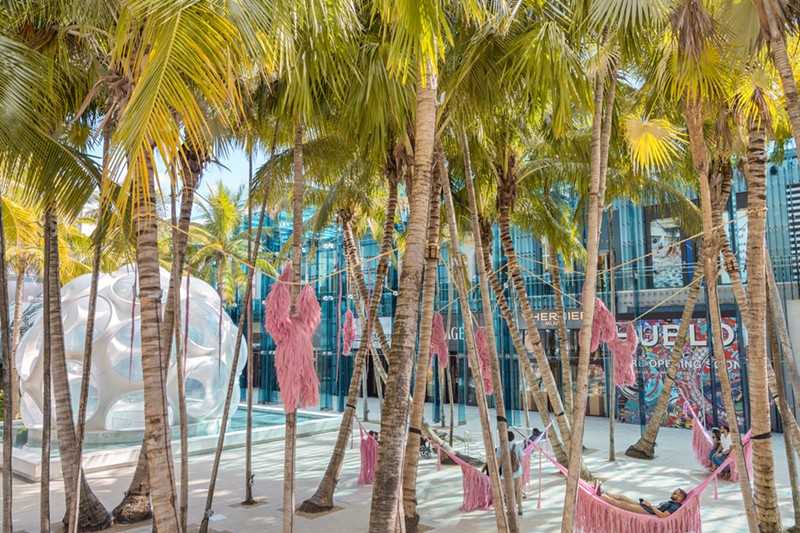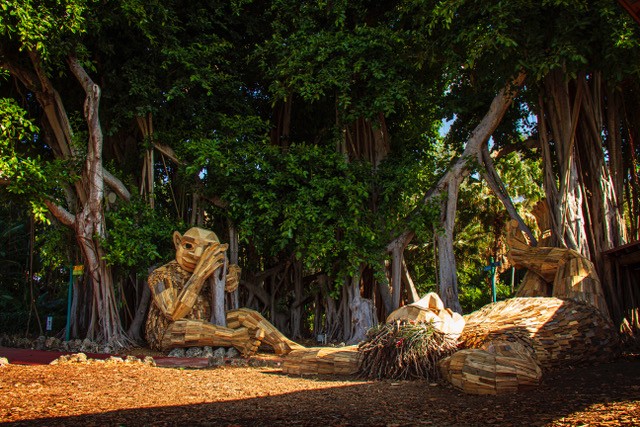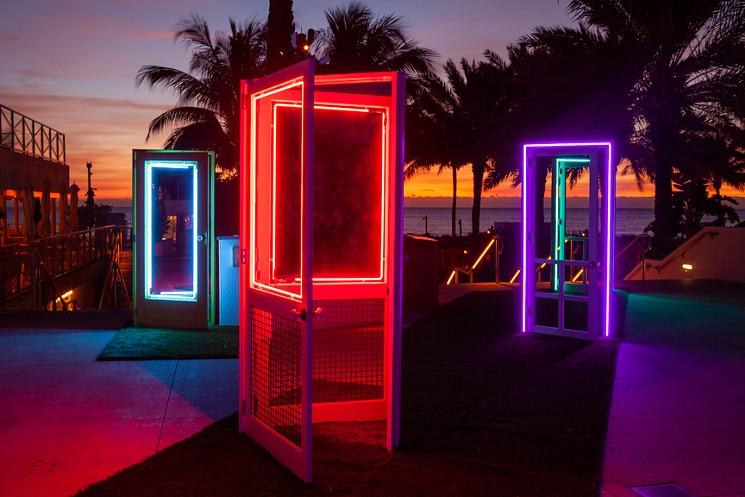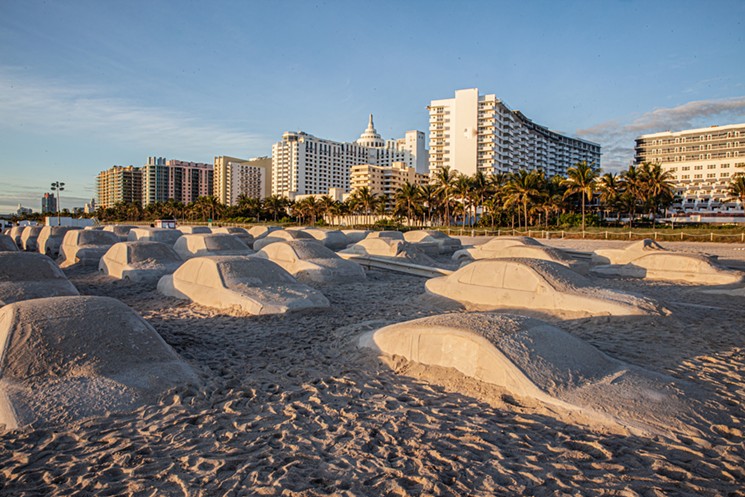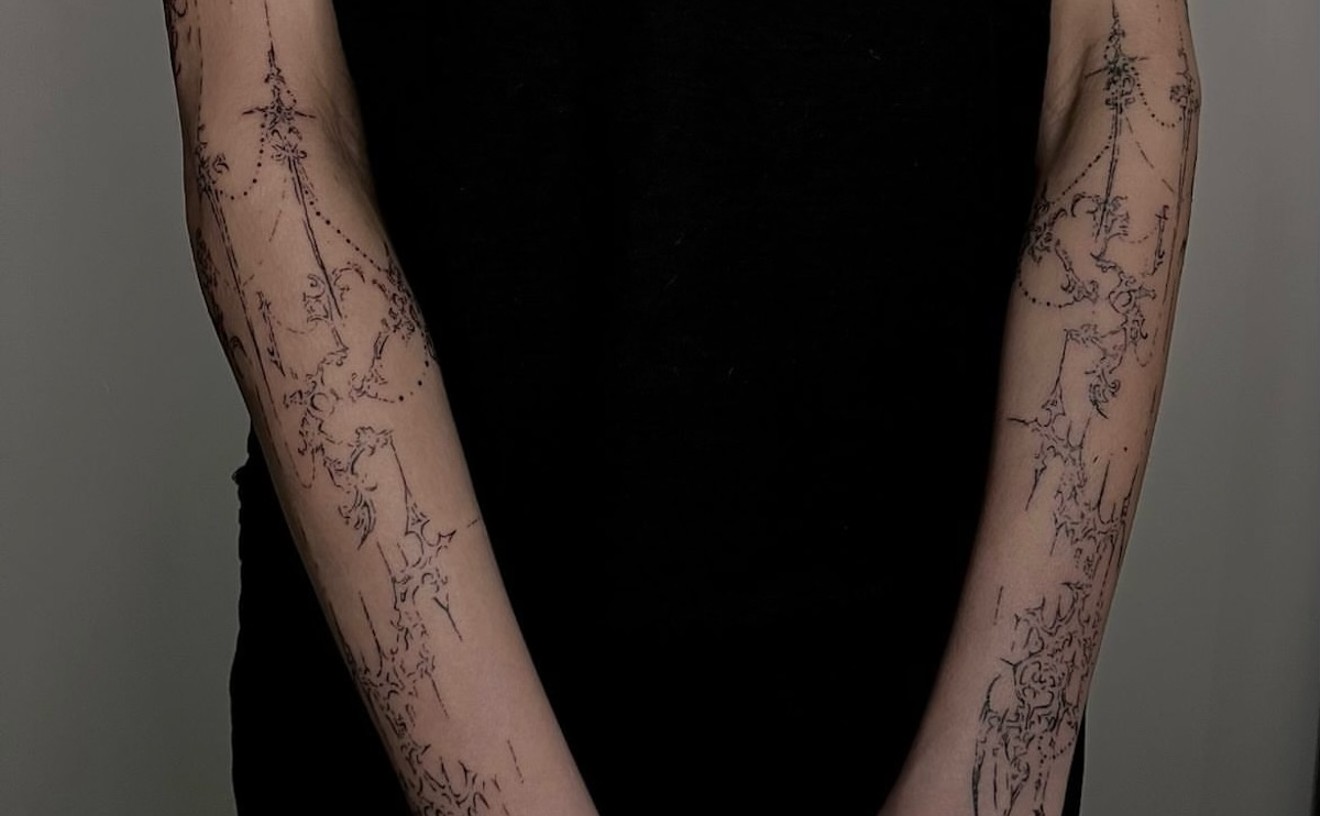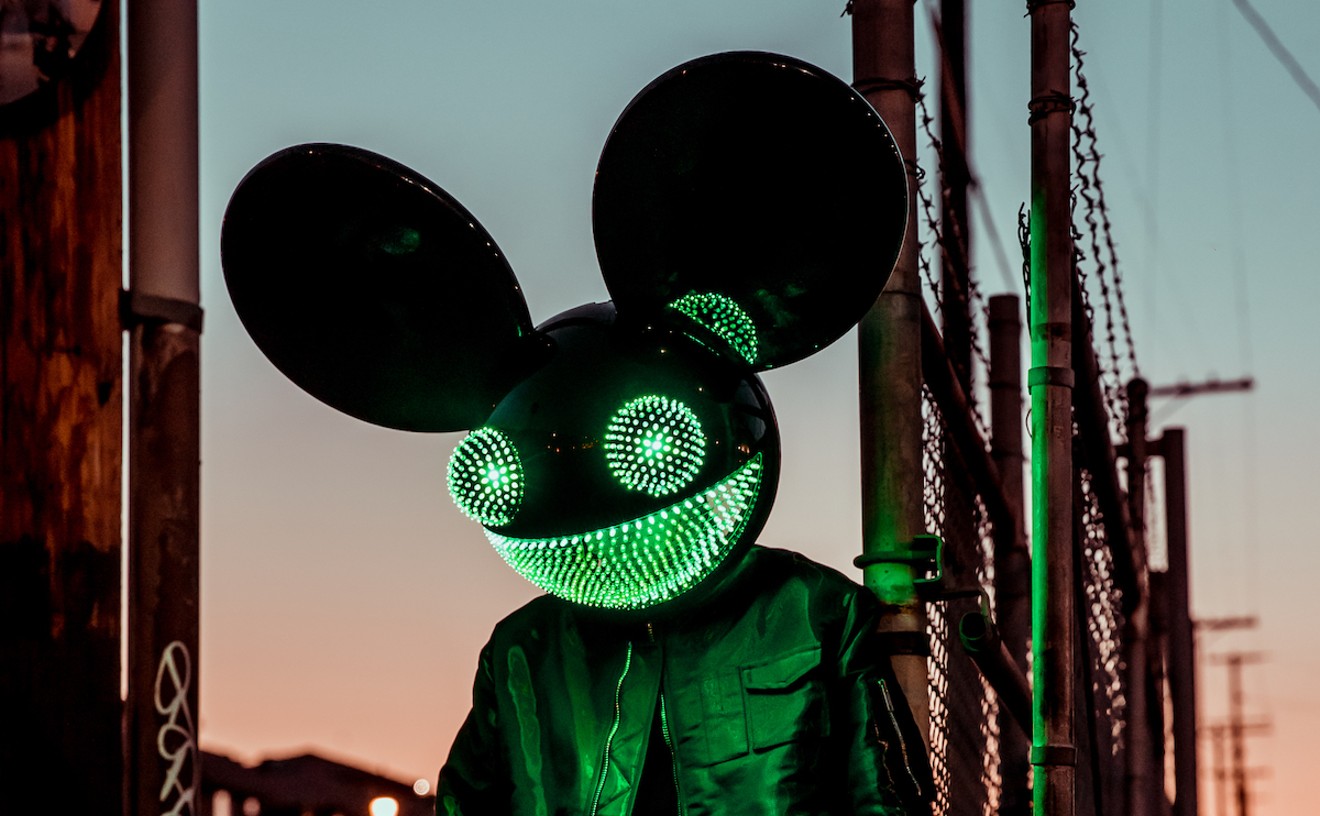Bright-Pink Sloths in the Trees
The next time you visit the Design District, you might be surprised to see a creature taking up residence in the neighborhood. The installation Pink Beasts features 30 giant pink sloths hanging from trees and archways, along with ten pink hammocks primed for lounging. But the sloths are more than a cute, fuzzy backdrop for an Instagram photo shoot. They also make a statement about sustainable, ethical design and draw attention to Mexico’s indigenous artisans.The sloths are the brainchild of designer Fernando Laposse, who works in London and Mexico. He connected with Angela Damman, a designer based in Yucatán, Mexico, who works alongside local artisans to produce textiles using natural plant fibers, and makes the hammocks used in the installation. Bringing the project to life was a team effort involving more than 60 people, most of whom are women weavers from the nearby Mayan village of Sahcabá. Using Damman’s facilities in Yucatán as a base, the designers worked side-by-side with the artisans, with Laposse traveled to Mexico several times during the process.
The sloths and hammocks are made from a material called sisal (or henequén in Spanish), which comes from the leaves of the agave plant. “The leaves get crushed, and inside the body of the leaves are these long fibers,” Laposse explains. From there, the stringy fibers are cleaned and brushed until they reach the desired quality. The process reduces some of the volume. To produce 650 kilos of fiber (the amount used for this project), they needed several tons of leaves.
Laposse had previously worked with the material for an installation in London, but he had never tried to dye it. To achieve the vibrant pigment of Pink Beasts, the team turned to the cochineal, a parasitic insect found on the prickly pear cactus, which has been used as a natural dye for thousands of years.
Laposse chose sloths for their symbolic potential as environmental ambassadors, as well as their sheer adorability.
“There’s something about cute animals that has a lot of power of drawing attention,” he says, citing the way images of pandas are used to bolster conservation efforts in China, or polar bears for the Arctic. “It’s also the way they live and move. This whole installation is about small-scale productions that take time, that take a lot of respect for nature. So it’s about slowing down, really. The sloth is a great embodiment of these kinds of principles.”
For Laposse and Damman, a goal of the project is to shine a spotlight on the work of indigenous communities, which have been working with these environmentally friendly processes for centuries, and connecting them to the global conversation about climate-change solutions and sustainability. “You’re not just coming in there and doing something with the community and leaving again,” Damman says. “Part of having a sustainable project is that they have a sustainable level of income and participation with designers and they know that there’s going to be other opportunities and recognition of who they are and their work.”
Pink Beasts. Through January 2020 in the Miami Design District, 305-722-7100; miamidesigndistrict.net.
Art Powered by Collective Mindfulness
For an installation that blends art with science, technology, and spirituality, look no further than the sculpture Ilumina at BaseCamp, the new immersive art park in Little Haiti meant to be a gathering place and event space for the community. The park is part of the larger development project the Magic City Innovation District, and several immersive art pieces dotted the area during Art Basel, including Ilumina, the sound and light installation The Cloud, and the dome Frequency, which holds classes in mindfulness and human connectivity. Ilumina, a tall vortex-shaped sculpture covered in geometric shapes that light the night sky, will stick around for the next few months.Debuted in 2017 for that year’s edition of Burning Man, Ilumina was created by Mexican artist Pablo González Vargas, who’s also behind the popular traveling art car, Mayan Warrior. The sculpture works by asking participants to sit in chairs surrounding the piece, where sensors equipped with HeartMath technology track their heartbeats and the amount of coherence — a measurement that’s found between heartbeats. “The more you are in a meditative state, or present and breathing, the more coherence you emanate,” Vargas says. “We average the coherence of the group, and that average triggers different levels of light and sound in the sculpture, so every time we run it, you see a different show.” It’s about being present and connecting as an individual and as a group.
It took a crew of around 30 people — including engineers, industrial designers, welders, and builders — six months to construct the original sculpture. A team of ten people spent ten days rebuilding it in Miami. At BaseCamp, the piece is activated about every 15 minutes. Vargas was inspired by the book Stealing Fire, which talks about the state of consciousness known as flow; as well as by sacred geometry, which made its way into several elements of the piece’s design. “It’s kind of expressing the universal flow of things and beings, and at the same time, people are in a meditative flow state to activate it,” Vargas says.
Ilumina. Through March 2020 at BaseCamp in the Magic City Innovation District, 298 NE 61st St., Miami; 305-504-8877; basecamp-miami.com.
Giant Trolls With a Message for Humans
Danish artist and designer Thomas Dambo is world-renowned for his enormous troll sculptures made from recycled materials. Each piece has a distinct personality and a fairy-tale-like backstory. Dambo’s trolls can be found everywhere from Denmark to South Korea to Colorado, and now they're at Pinecrest Gardens in South Miami-Dade.Pinecrest's trolls, named Berta and Terje, are siblings. As Dambo’s story goes, the two orphaned trolls wandered through the forest in search of their mother and stopped in a clearing to rest when they grew tired. As they slept under a beautiful banyan tree, they dreamed of the “little people” who poured poison into the “eternity stream.” The stream turned into a river, which became an ocean, which evaporated into the skies and became rain. “The little people are obviously the humans, and this is an analogy of how when you throw stuff out, it stays around, and the world is a living organism that mixes, and that’s why we can now find microplastic in our own blood,” Dambo explains. “For me, the trolls are kind of like guardians or gods that protect nature. I think it’s funny to write the stories through the eyes of the trolls, and they look at us as small.” Dambo also built a troll in Wynwood for Miami Art Week; he's the younger brother, who curiously picks up a car tire and wonders why humans spend so much of their time riding around in these things.
One troll requires about 10,000 screws, 3,000 pieces of wood, and 500 to 1,000 hours to make. At Pinecrest Gardens, Dambo enlisted a team of volunteers to help him and his crew with the building process. The trolls’ faces are made from plywood boxes on wheels that Dambo sources from a store called Flying Tiger whenever its employees throw them out to make room for new inventory. “I have got almost 1,000 of these big wooden boxes in my warehouse, and we take those boxes apart and they become the faces,” he says.
The trolls are meant to be interactive and often become fixtures in the places they reside. In Puerto Rico, for instance, after the troll Hector el Protector was destroyed in Hurricane Maria, locals left flowers where he had stood (Dambo returned this year to rebuild him). Dambo likes to see people climbing on the trolls and connecting with their story. “It goes all the way back to my core statement of having people understand that trash is not a bad thing,” he says. “If people touch it and love it, then they will have a better relationship with trash, because it is a big problem. We think if we don’t need it, nobody needs it, but that’s not the truth. There’s always somebody else that needs it.”
Giant Trolls. Pinecrest Gardens, 11000 Red Rd., Pinecrest; 305-669-6990; pinecrestgardens.org.
Doorways to Unknown Worlds
Artist Sandra Muss has long had a fascination with doors and the sense of transformation they can evoke. “I think it’s just about opening universes or stepping through — being courageous or not being courageous,” she says, “and there are so many different kinds of doors, speaking visually.” She’s inspired by books such as The Lion, the Witch and the Wardrobe — “how all of a sudden you are in another universe.”As the Pulse Project Artist of 2019 during this year’s Miami Art Week, Muss presented two installations at Pulse Art Fair. Portals: Dreams of Flight — a piece inspired by cicada wings that included recorded cicada songs — stood near the fair’s entrance, and Open Doors, which included seven repurposed wooden doors, was incorporated into the environment outside the Eden Roc Hotel. Some of the doors had mirrors, reflecting viewers back at themselves as they peered through them. Other doors framed the hotel’s pathways and the distant ocean and allowed visitors to walk through and get a different view of their environment.
Muss found the doors in the Berkshires in Massachusetts, where she lives part of the year. She also worked with sound designer Jules Jenssen to add an audio element to the experience. Using a weather-controlled system, he created a series of loops that would play based on the wind direction, wind speed, and temperature. Depending upon the moment, the spectator might hear the sound of a train station in Kyoto, Japan; the noises of a distant jungle; or a quote from an Emily Dickinson poem, heightening one's imagination even further as one faces the open doorway.
Though Muss originally considered herself a painter, she grew interested in site-specific work a few years ago. “All of a sudden, things just shifted: My vision became three-dimensional instead of two-dimensional,” she says. “I love site-specific works because the site plays into whatever I’m doing. You have your own ways of making art, but you totally become part of — or the works becomes part of, or inspired by, a particular spot.” Though her Pulse installations were temporary, Muss is set to return to Miami in early February with an exhibit at Artscape Lab — “What Will You Leave Behind” — where viewers can see much more of her large-scale, site-specific work.
“What Will You Leave Behind.” February 6 through April 3, 2020, at Artscape Lab, 7255 NE Fourth Ave., Suite 113, Miami; 305-979-3855; artscapelab.com.
A Traffic Jam Sculpted in Sand
Miamians are accustomed to traffic jams, but they've probably never seen one in the sand before. Argentine artist Leandro Erlich’s Order of Importance — a fleet of 66 life-size sculptures of cars and trucks — recently took over the beach at Lincoln Road, where it proceeded to disintegrate and generate a whirlwind of attention. Commissioned by the City of Miami Beach, the sculptures are made from sand and meant to comment on the dangers of climate change. By creating a 21st-century traffic jam in sand, the project juxtaposes natural materials with the realities and demands of modern life. Over the course of the exhibit’s life, the cars and trucks have gradually degraded and disappeared into the beach. However, after the immense attention the exhibit garnered, one car is planned to be restored and exhibited through the Super Bowl in February.The installation is Erlich’s largest work to date and was the source of many selfies and much exploration during Miami Art Week. “Climate change and its consequences are no longer a matter of perspective or opinion,” Erlich said in a statement. “The climate crisis has become an objective problem that requires immediate solutions. As an artist, I am in a constant struggle to make people aware of this reality, in particular, the idea that we cannot shrink away from our responsibilities to protect the planet.”
Order of Importance. South Beach on the sand at Lincoln Road, miamibeachfl.gov.

